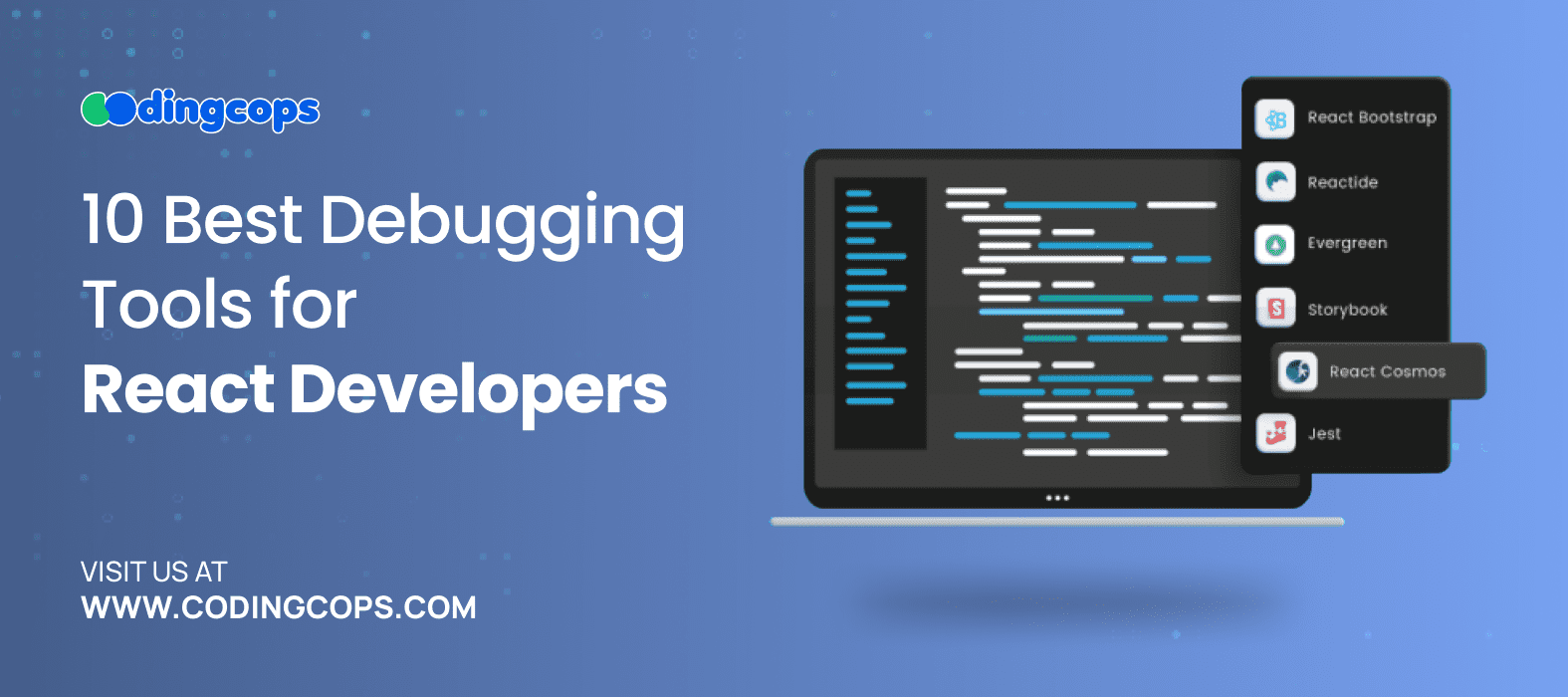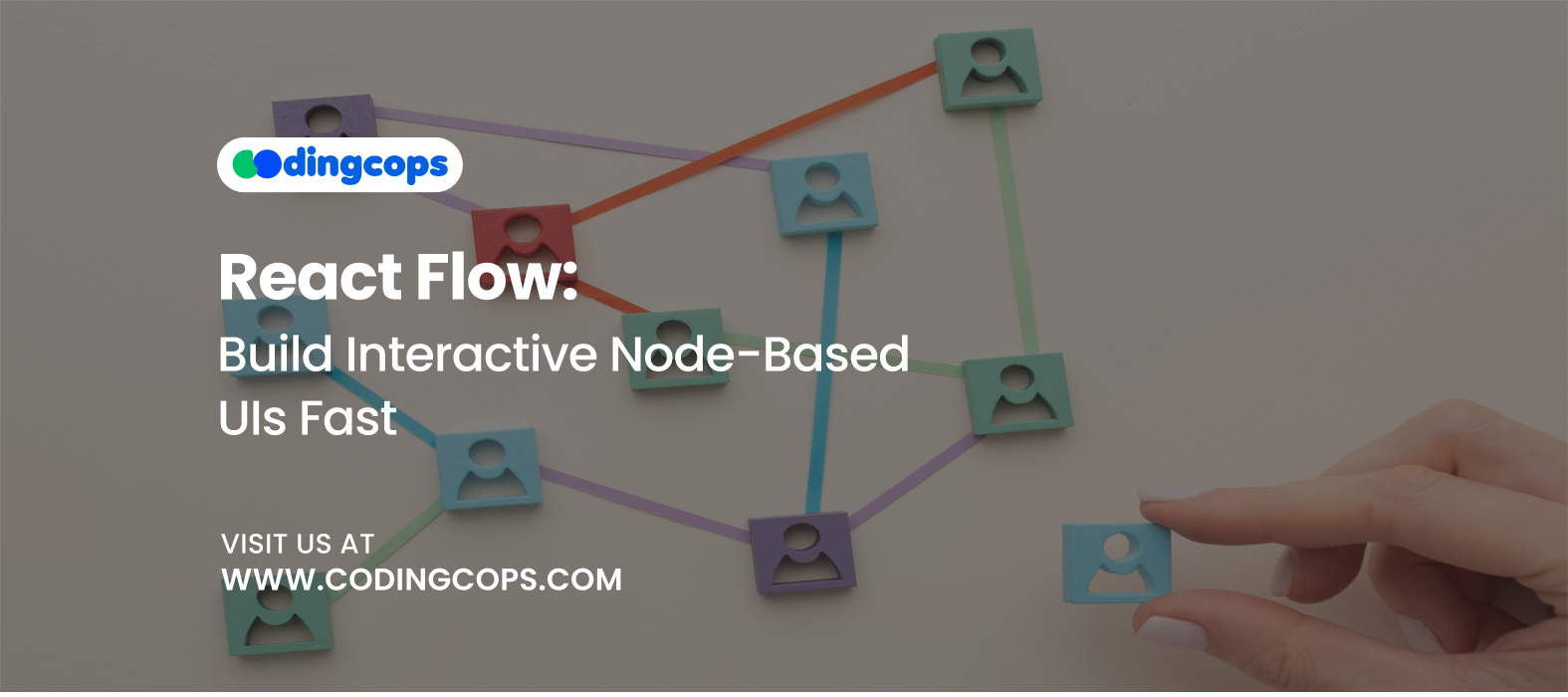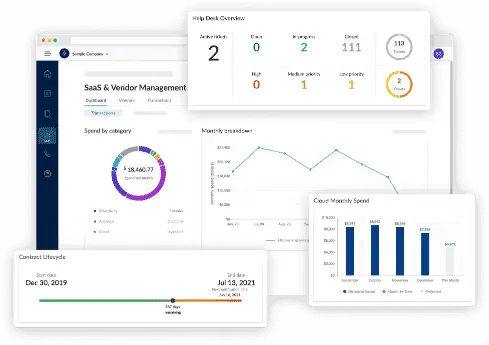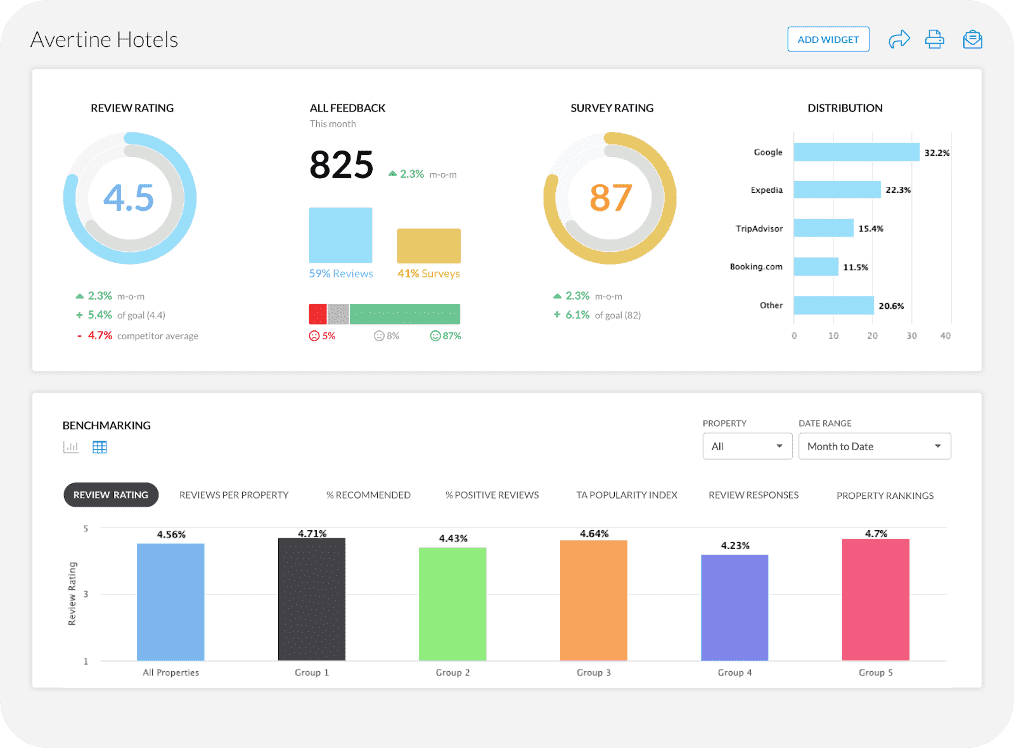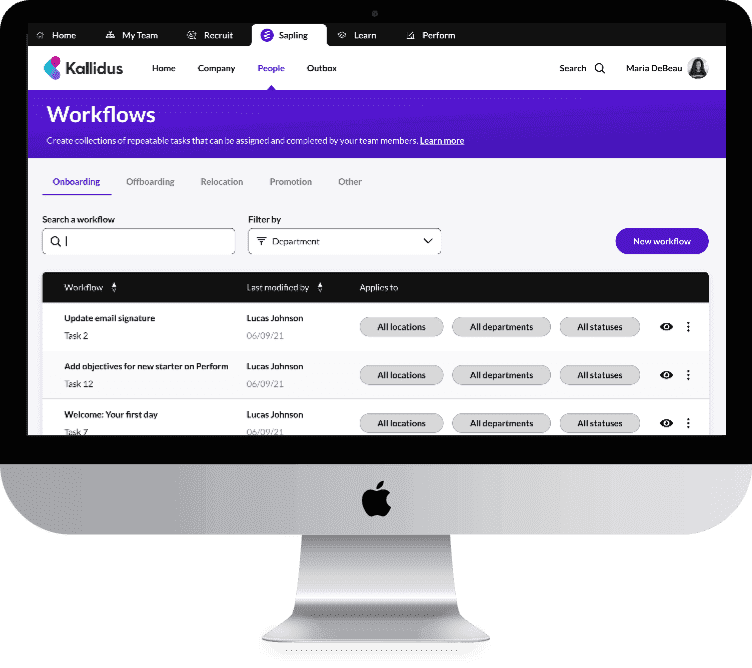It’s been days now since we have been telling you that React is one of the most popular and top-notch front-end web development frameworks with over 39% popularity, which is just behind Node.js. Now, it’s time to understand some modern and advanced-level React JS concepts that are used by React developers in building interactive applications.
With React, you can build dynamic and engaging user interfaces. React’s component-based architecture, declarative UI, and virtual DOM are splendid features that make it a preferred choice for developers and big businesses.
So, if you want to master React or hire React developers for your development project, the below-given advanced React JS components are a must-have for a developer. These concepts are crucial for improving performance, scalability, and maintainability.
So, let’s start!
Core React JS Principles
React Component Lifecycle
Let’s understand the React Component Lifecycle first. It is fundamental aspect of React responsible of governing the creation, updation, and destruction or components. It is important for developers to understand React Component Lifecycle to attain granular control over specific actions during component’s existence.
Component Lifecycle Methods include:
- componentDidMount
- componentDidUpdate
- componentWillUnmount
Advanced Component Design Patterns
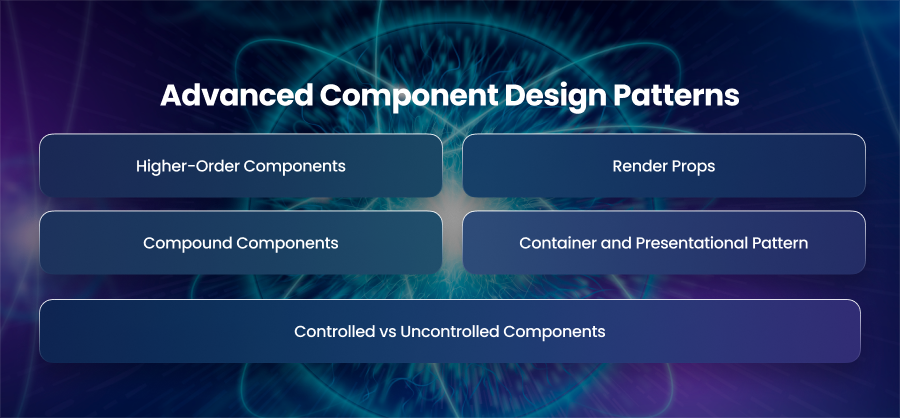
When it comes to modern React development, you have to heavily rely on reusable design patterns. These reusable patterns assist you in keeping your code clean and maintainable.
Here is the list of advanced component design patterns that support React development.
Higher-Order Components
These are the functions that encapsulate other components to add logic or behavior including data retrieval, logging, or authentication, without changing the original component.
Render Props
By giving a function as a prop that dynamically decides what gets rendered, render props allow components to exchange code, encouraging reusability and separation of concerns.
Compound Components
Such components are perfect for intricate UI elements like tabs, accordions, or toggles. These components allows many components to collaborate and share data implicitly via React Context.
Container and Presentational Pattern
This design pattern separates UI and business logic. Containers are used to manage state and logic, whereas presentational components focus entirely on UI rendering.
Controlled vs Uncontrolled Components
The uncontrolled components use refs to store the state inside the DOM, ensuring more flexibility when required. On the other hand, the controlled components rely on React State to handle the input.
React Hooks
React Hooks are the special functions in React that allow you to use state and other React features in functional components. Previously, these features were only available in class components.
Some common React hooks include useState, useEffect, useContext, etc.
Role of React Hooks in Advanced React Development
- Cleaner Code with Functional Components: With no need for class components, hooks improve the readability, conciseness, and testing ability of the code.
- Better State Management: Hooks play a crucial role in in managing the state of the React application. useReducer and other custom hools allow developers to manage modular and scalable state logic in large applications.
- Performance Optimization: Another perk of React Hooks is the ability of performance optimization. By using the right hooks such as useMemo and useCallback, you can avoid expensive recalculations and rerenders. Further, useRef assists in preventing unnecessary state updates.
- Custom Hooks Reusability: With custom hooks, you have the ability to encapsulate the logic and reuse it across various components.
- Integration with Other Libraries: Lastly, it becomes effortless to integrate with libraries like Redux using Hooks. Moreover, you can even integrate to animations libs such as Framer Motion.
State Management with Redux
Redux is a top-notch state management library capable of managing application-level state in a predictable and centralized manner. It is especially useful for large and complex React applications where components communicate with each other largely.
Redux in React – An Overview
- Redux helps in centralized state management by keeping the global app state in one place. Resulting in improving the structure and visibility.
- It gives predictable state changes. Using pure reducers, state transitions become predictable and testable.
- Using Redux improves debugging. It is possible by using Redux DevTools as they show the entire state history, easing the debugging process.
- If your system has deep nested components or complex UI logic, Redux is there to support it. It is ideal for such systems.
When to Use Redux
You should choose Redux in your app, if:
- Application shares data between many components
- There is complex state logic
- You need enhanced debugging tools
- Needs global state persistence
React Router
You may move between views or components in a single-page application using this React standard routing module without having to reload the page. Unlike standard apps that load a new HTML page from the server with each URL request, the React Router dynamically modifies components based on the URL.
Additionally, it offers a better user experience because users can use the back/forward buttons organically and URLs reflect the current views. Along with this, it supports nested routes, lazy loading, and route protection which are great things for large applications.
Moreover, you enjoy separation of concerns using the React Router as you can clearly define which component should render on which URL. Thus, it improves the overall organization of the applicaiton.
Context API
You can transfer state (or any value) between components using the built-in React Context API capability instead of manually passing props through each level of the component tree, which is another problem known as “prop drilling”.
Role of Context API in React Development
- Global State Sharing: Context API makes it easier to share state across distant components such as user auth, language, dark mode, etc.
- Avoids Prop Drilling: With Context API, there’s no need to pass props through intermediate components just to reach deeply nested ones.
- Better Component Structure: Moreover, it keeps components focused in their logic, without worrying about unnecessary props.
- Lightweight Alternative to Redux: Further, it assisted in state management as it is a lightweight alternative to Redux. It is exceptional for small to medium-scale global states. Hence, if your app doesn’t need complex state logic, you can use Context API.
- Custom Context + Hooks: Lastly, you can build your own custom hooks to encapsulate reusable logic.
Note: Avoid using Context API for frequent updates or high-performance needs. It can cause unnecessary re-renders. For such cases, Redux is the best solution.
React Performance Optimization
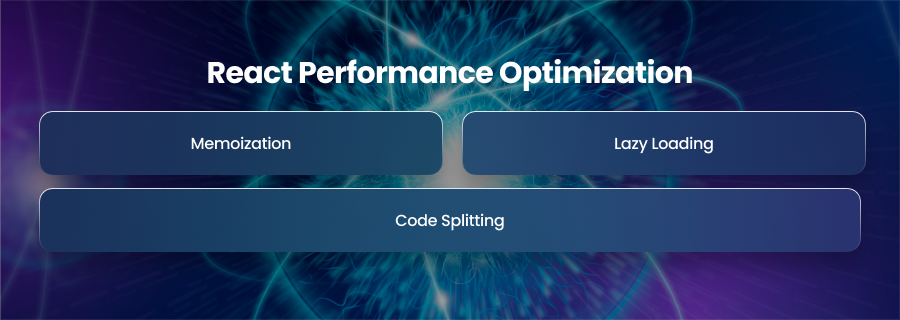
Optimizing a React application is itself an advanced ReactJS concept that covers many techniques. These techniques can be used when the React application grows in complexity. So, let’s explore the React performance optimization techniques.
Memoization
Firstly, we have memoization that plays its role to optimize expensive calculations or functions by caching the results. It prevents unnecessary re-renders of components or functions that contribute to improving the overall performance of the application.
React.memo, useMemo, and useCallback are used for memoization in React.
Need for Memoization
When state or props change in React, components re-render even if the component itself is unaffected. Large applications or costly activities may have performance issues, such as filtering, sorting, or generating lengthy lists.
Such issues are resolved with memoization, which helps React avoid spending time on re-rendering or re-computing unless required.
Lazy Loading
Lazy loading in React refers to stopping the loading of resources or components until they are truly required. The user experience is improved, performance is improved, and the initial load time is decreased.
In React applications, loading or importing all components at once can make the initial bundle size large which can cause issues such as:
- Slower page loads
- Longer Time to Interactive
- Poor performance on slow networks
So, lazy loading solves all such problems by splitting your code into chunks and only loading pieces that are necessary.
Benefits of Lazy Loading
- Provides faster initial load times
- better performance on low-end devices
- Efficient resource usage
- Improved user experience
Code Splitting
In React, code splitting is a technique by which developers split the application’s bundle into smaller chunks. Instead of loading at once, these chunks are only loaded when needed. Hence, this improves the initial load time and performance of the React application.
Benefits of Code Splitting
- Furnishes faster initial load by only loading essential code.
- Enhances performance, especially on slow networks
- Promotes efficient memory usage by only loading the chunks when needed
- Exceptional for scaling large-scale applications
With code splitting, your React application enhances performance by applying an optimizing strategy with smaller, lazy-load pieces.
React Testing
Testing is a core part of any software development process, and so does React development. In React, testing is done at different levels and manners.
Let’s find out more about testing in React.
Unit Testing with Jest
Jest is a popular testing framework that is widely used for unit testing of React components. With Jest, developers are empowered to write test cases to ensure that individual components behave as per expectations and requirements.
With unit testing, it is easier to identify and fix bugs at the earlier stages of the Reat application development.
Integration Testing with React Testing Library
React testing library is a lightweight tool for testing React components. It provides utilities for React components in a more realistic manner by simulating user interactions.
Moreover, integration testing ensures that different components work together according to the set expectations and intentions. Hence, it helps validate the application’s overall functionality.
Ending Notes
So, while we end this informational blog, we must say that the list of advanced React JS concepts is very long; we only mentioned the core advanced concepts that play their part often in React development. Mastering advanced concepts is essential for building large-scale, modern applications.



